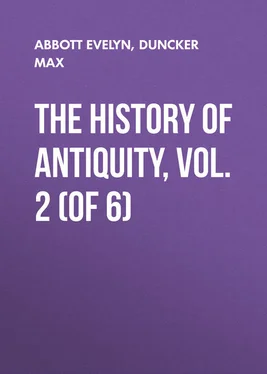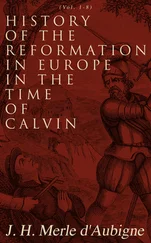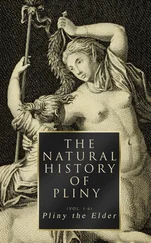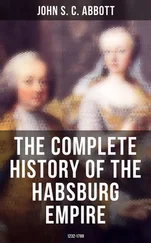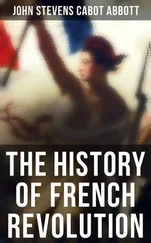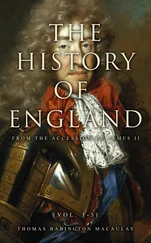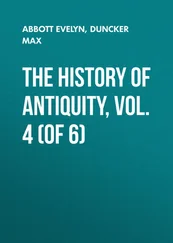Evelyn Abbott - The History of Antiquity, Vol. 2 (of 6)
Здесь есть возможность читать онлайн «Evelyn Abbott - The History of Antiquity, Vol. 2 (of 6)» — ознакомительный отрывок электронной книги совершенно бесплатно, а после прочтения отрывка купить полную версию. В некоторых случаях можно слушать аудио, скачать через торрент в формате fb2 и присутствует краткое содержание. Жанр: foreign_antique, foreign_prose, Историческая проза, на английском языке. Описание произведения, (предисловие) а так же отзывы посетителей доступны на портале библиотеки ЛибКат.
- Название:The History of Antiquity, Vol. 2 (of 6)
- Автор:
- Жанр:
- Год:неизвестен
- ISBN:нет данных
- Рейтинг книги:4 / 5. Голосов: 1
-
Избранное:Добавить в избранное
- Отзывы:
-
Ваша оценка:
- 80
- 1
- 2
- 3
- 4
- 5
The History of Antiquity, Vol. 2 (of 6): краткое содержание, описание и аннотация
Предлагаем к чтению аннотацию, описание, краткое содержание или предисловие (зависит от того, что написал сам автор книги «The History of Antiquity, Vol. 2 (of 6)»). Если вы не нашли необходимую информацию о книге — напишите в комментариях, мы постараемся отыскать её.
The History of Antiquity, Vol. 2 (of 6) — читать онлайн ознакомительный отрывок
Ниже представлен текст книги, разбитый по страницам. Система сохранения места последней прочитанной страницы, позволяет с удобством читать онлайн бесплатно книгу «The History of Antiquity, Vol. 2 (of 6)», без необходимости каждый раз заново искать на чём Вы остановились. Поставьте закладку, и сможете в любой момент перейти на страницу, на которой закончили чтение.
Интервал:
Закладка:
What population the Phenicians found on Cyprus it is not possible to discover. Herodotus tells us that the first inhabitants of the island were Ethiopians, according to the statements of the Cyprians. It is beyond a doubt that not Citium only, but the greater part of the cities of the island were founded by the Phenicians, and that the Phenician element became the ruling element of the whole island. 74 74 Herod. 7, 90.
It is Belus who is said to have conquered Cyprus, and to whom the city of Citium is said to belong; i. e. Citium worshipped the god Baal. At Amathus, to the west of Citium, on the south coast of the island, which was called the oldest city on Cyprus, and which nevertheless bears a distinctly Semitic name (Hamath), Adonis and Ashera-Astarte were worshipped, 75 75 Stephan. Byz. Ἀμαθοῦς.
and these deities had also one of their oldest and most honoured seats of worship at Paphos (Pappa in the inscriptions), on the west coast. The Homeric poems represent Aphrodite as hastening to her altar at Paphos in Cyprus. Pausanias observes that the Aphrodite of Cyprus was a warlike Aphrodite, 76 76 "Odyss." 8, 362; Tac. "Annal." 2, 3; Pausan. 1, 14, 6; Pompon. Mela, 2, 7.
and as the daughters of the Cyprians surrendered themselves to the foreign seamen in honour of this goddess, 77 77 Vol. i. p. 359.
it was the Astarte-Ashera of the Phenicians who was worshipped at Amathus and Paphos. The Zeus of the Cyprian city Salamis (Sillumi in the inscriptions of the Assyrians), to whom, according to the evidence of western writers, human sacrifices were offered, can only be Baal Moloch, the evil sun-god of the Phenicians. In the beginning of the tenth century B.C. the cities of Cyprus stood under the supremacy of the king of Tyre. 78 78 Joseph. "in Apion." 1, 18; "Antiq." 8, 5, 3, 9, 14, 2.
The island was of extraordinary fertility. The forests furnished wood for ship-building; the mountains concealed rich veins of the metal which has obtained the name of copper from this island. 79 79 Movers, "Phœniz." 2, 239, 240.
Hence it was a very valuable acquisition, an essential strengthening of the power of Sidon in the older, and Tyre in the later, period.
Following Zeno of Rhodes, who wrote the history of his home in the first half of the second century B.C., 80 80 Diod. 5, 56.
Diodorus tells us: The king of the Phenicians, Agenor, bade his son Cadmus seek his sister Europa, 81 81 In Homer Europa is not the daughter of Agenor but of Phœnix ("Il." 14, 321), just as Cadmus, Thasos, and Europa are sometimes children of Agenor and sometimes of Phœnix. In Hdt. 1, 2 it is Cretans who carry off Europa, the daughter of the king of Tyre.
who had disappeared, and bring back the maiden, or not return himself to Phœnicia. Overtaken by a violent storm, Cadmus vowed a shrine to Poseidon. He was saved, and landed on the island of Rhodes, where the inhabitants worshipped before all other gods the sun, who had here begotten seven sons and among them Makar. Cadmus set up a temple in Rhodes to Poseidon, as he had vowed to do, and left behind Phenicians to keep up the service; but in the temple which belonged to Athena at Cnidus in Rhodes he dedicated a work of art, an iron bowl, which bore an inscription in Phenician letters, the oldest inscription which came from Phœnicia to the Hellenes. From Rhodes Cadmus came to Samothrace, and there married Harmonia. The gods celebrated this first marriage by bringing gifts, and blessing the married pair to the tones of heavenly music. 82 82 Diod. 4, 2, 60; 5, 56, 57, 58, 48, 49.
Ephorus says that Cadmus carried off Harmonia while sailing past Samothrace, and hence in that island search was still made for Harmonia at the festivals. 83 83 Ephor. Frag. 12, ed. Müller.
Herodotus informs us that Cadmus of Tyre, the son of Agenor, in his search for Europa, landed on the island of Thera, which was then called Callisto, and there left behind some Phenicians, either because the land pleased him or for some other reason. These Phenicians inhabited the island for eight generations before Theras landed there from Lacedæmon. The rest went to the island of Thasos and there built a temple to Heracles, which he had himself seen, and the city of Thasos. This took place five generations before Heracles the son of Amphitryon was born. After that Cadmus came to the land now called Bœotia, and the Phenicians who were with him inhabited the land and taught the Hellenes many things, among others the use of writing, "which as it seems to me the Hellenes did not possess before. They learnt this writing, as it was used by the Phenicians; in the course of time the form of the letters changed with the language. From these Phenicians the Ionians, among whom they dwelt, learnt the letters, altered their form a little, and extended their use. As was right, they called them Phenician letters, since the Phenicians had brought them into Greece. I have myself seen inscriptions in Cadmeian letters ( i. e. from the time of Cadmus) in the temple of Ismenian Apollo at Thebes." 84 84 Herod. 4, 147; 2, 45, 49; 5, 58, 59.
According to the narrative of Hellanicus, Cadmus received an oracle, bidding him follow the cow which bore on her back the sign of the full moon, and found a city where she lay down. Cadmus carried out the command, and when the cow lay down wearied, where Thebes now stands, Cadmus built there the Cadmeia (the citadel of Thebes). 85 85 Frag. 8, 9, ed. Müller.
According to the statement of Pherecydes Cadmus also built the city of Thebes. 86 86 Frag. 40-42, 43-45, ed. Müller.
With Hecatæus of Miletus Cadmus passes as the discoverer of letters; according to others he also discovered the making of iron armour and the art of mining. 87 87 Frag. 163, ed. Müller.
The direction of the Phenician settlements, which proceeds in the Ægean sea from S.E. to N.W., cannot be mistaken in these legends. First Rhodes, then the Cyclades, then the islands on the Thracian coast, Samothrace and Thasos, were colonised; and at length, on the strait of Eubœa, the mainland of Hellas was trodden by the Phenicians, who are said to have gained precisely from this point a deep-reaching influence over the Hellenes. The legend of Cadmus goes far back among the Greeks. In the Homeric poems the inhabitants of Thebes are "Cadmeians." The Thebaid praised "the divine wisdom of Cadmus;" in the poems of Hesiod he leads home Harmonia, "the daughter of Ares and Aphrodite," and Pindar describes how the Muses sang for "the divine Cadmus, the wealthiest of mortals, when in seven-gated Thebes he led the ox-eyed Harmonia to the bridal-bed." 88 88 "Theog." 937, 975; Pind. "Pyth." 3, 88 seqq.
Agenor, the father of Cadmus, is a name which the Greeks have given to the Baal of the Phenicians. 89 89 Movers, "Phœniz." 1, 129, 131.
Cadmus himself, the wealthiest of mortals, who leads home the daughter of a god and a goddess, – who celebrates the first marriage at which the gods assemble, bring gifts and sing, – whose wife was worshipped as the protecting goddess of Thebes, 90 90 Plut. "Pelop." c. 19.
– whose daughters, Ino, Leucothea and Semele, are divine creatures, whom Zeus leads to the Elysian fields, 91 91 Pind. "Olymp." 2, 141.
– can only be a god. He seeks the lost Europa, and is to follow the cow which bears the sign of the full moon. We know the moon-goddess of the Phenicians, who bears the crescent moon and cow's horns, the horned Astarte, who wears a cow's head, the goddess of battle and sensual desire, and thus the daughter of Ares and Aphrodite. "The great temple of Astarte at Sidon," so we find in the book of the Syrian goddess, "belongs, as the Sidonians say, to Astarte; but a priest told me that it was a temple of Europa, the sister of Cadmus." The meaning of the word Europa has been discussed previously (I. 371). Cadmus, who seeks the lost moon-goddess, who at length finds and overcomes her, and celebrates with her the holy marriage, is the Baal Melkarth of the Phenicians. The death-bringing Istar-Astarte is changed into Bilit-Ashera, into the fruit-giving goddess; 92 92 Vol. i. 271.
the gloomy Europa changes into Harmonia, the goddess of union, birth and increase, yet not without leaving to her descendants deadly gifts. It is the myth of Melkarth and Astarte which the Greeks present to us in the story of Cadmus; with this myth they have connected the foundation of the Phenician settlements in Rhodes, Thera, Samothrace, Thasos and Bœotia; they have changed it into the foundation of these colonies. The name Cadmus means the man of the East; to the Hebrews the Arabs who dwelt to the east of them were known as Beni Kedem, i. e. sons of the East. 93 93 Movers, "Phœniz." 1, 517.
To the Greeks the Phenicians were men of the East, just as to the English of the thirteenth century the merchants of Lubeck were Easterlings. The citadel of Thebes, which the men of the East built, preserved the name of Cadmus the son of the East, and kept it alive among the Greeks.
Интервал:
Закладка:
Похожие книги на «The History of Antiquity, Vol. 2 (of 6)»
Представляем Вашему вниманию похожие книги на «The History of Antiquity, Vol. 2 (of 6)» списком для выбора. Мы отобрали схожую по названию и смыслу литературу в надежде предоставить читателям больше вариантов отыскать новые, интересные, ещё непрочитанные произведения.
Обсуждение, отзывы о книге «The History of Antiquity, Vol. 2 (of 6)» и просто собственные мнения читателей. Оставьте ваши комментарии, напишите, что Вы думаете о произведении, его смысле или главных героях. Укажите что конкретно понравилось, а что нет, и почему Вы так считаете.
